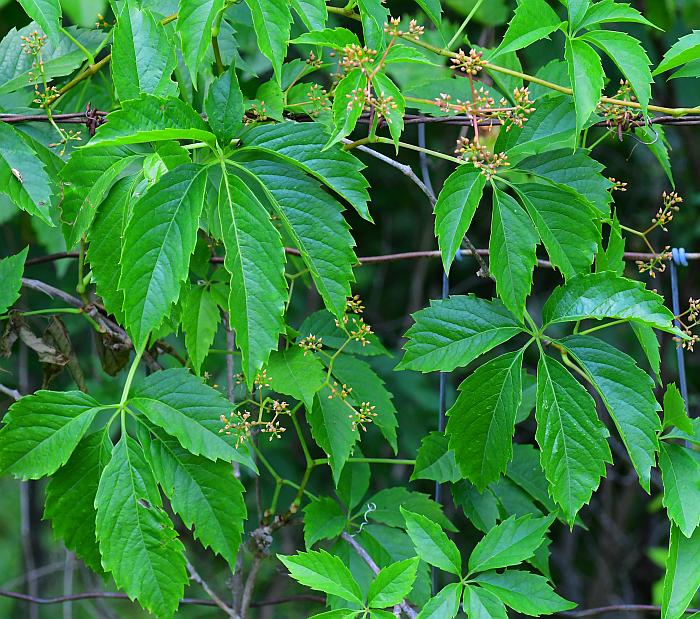Parthenocissus vitacea (Knerr) Hitchc.
Woodbine, Thicket Creeper

Native
CC = 3
CW = 3
MOC = 9
© SRTurner
Parthenocissus vitacea (Knerr) Hitchc.Woodbine, Thicket Creeper | |
 |
Native CC = 3 CW = 3 MOC = 9 |
© SRTurner |
|
Family - Vitaceae Habit - Liana. Stems - Scrambling on the ground or climbing on supports, to 10 m. Young stems grayish brown to reddish brown, glabrous. Older stems gray to dark brown, sometimes appearing somewhat warty with small lenticels, eventually developing dark brown, deeply fissured, nonshredding bark, the pith white, not or only rarely chambered.
Leaves - Alternate, compound, with tendrils at scattered nodes. Tendrils with 3-5 branches, the tips slender, very rarely a few with circular adhesive discs. Leaf blades once palmately compound, usually with 5 leaflets. Leaflets 3-12 cm long, elliptic to obovate, tapered or narrowed at the base, tapered to a sharply pointed tip, the margins sharply and usually coarsely toothed mostly above the midpoint, herbaceous or somewhat papery, not thickened, shiny, glabrous, dark green on the upper surface, paler and glabrous or hairy on the undersurface.
Inflorescences - Inflorescences opposite the leaves, mostly wider than long, lacking a well-defined central axis, usually with 2 main branches at the tip of the stalk, each of these 1-3 times dichotomously forked, the 10-60 flowers single or in small clusters at the branch tips.
Flowers - Calyces fused into a low spreading collar. Petals 5, free, 2-3 mm long, persistent and spreading at flowering, yellowish green. Stamens 5. Nectar disc reduced, indistinct, entirely fused to the ovary. Pistil 1 per flower. Style short, not persistent at fruiting.
Fruits - Globose berries 10-12 mm in diameter, dark blue to nearly black at maturity. Seeds 1-4 per fruit, 4.5-5.0 mm long, the surface somewhat roughened or wrinkled, light brown to brown. Flowering - May - July. Habitat - Streambanks, bases and ledges of bluffs, forests, fencerows. Origin - Native to the U.S. Lookalikes - Parthenocissus quinquefolia. Other info. - This species, unlike the common Virginia creeper (P. quinquefolia), is uncommon in Missouri, known from only a few scattered locations across the state. It is much more common in other parts of the U.S., with its main range extending in a broad band from the Southwest through New England and into Canada. Vegetatively it appears very similar to common Virginia creeper. However, the inflorescences are broad and branched, lacking the central axis found in the inflorescences of P. quinquefolia. The inflorescences are also more numerous and, within the proper season, commonly observed. Common Virginia creeper, in contrast, tends to flower sporadically and only from portions of the plant which hang downward from an above support. The tendrils of P. vitacea almost never form the minute adhesive disks which are a feature of P. quinquefolia tendrils at points where the tips contact surfaces. Photographs taken at Chloe Lowry Marsh Natural Area, Mercer County, MO, 6-17-2018, and near Goodrich, Genesee County, MI, 7-3-2022 (SRTurner). |